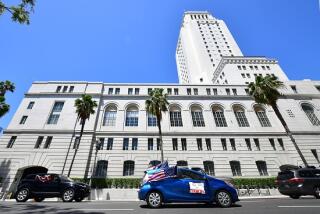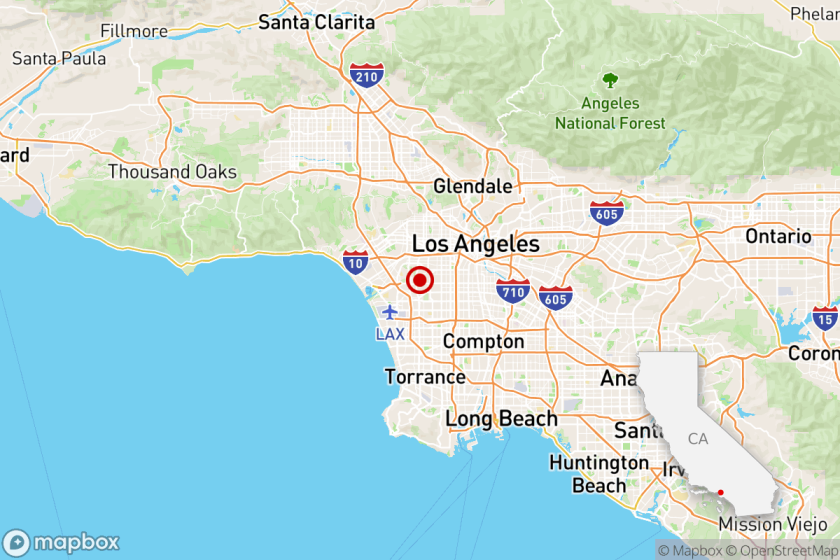Minority representation a challenge for redistricting commission
Many of L.A.’s black leaders gathered in Exposition Park one recent drizzly morning to sound a warning.
Hard-won political gains were under attack, they said, in the once-in-a-decade redrawing of California’s voting districts. There were references to the civil rights movement of the 1960s and exhortations to “let your voice be heard.” The leaders urged their audience to lodge protests with the citizen group formed at voters’ behest to create the new political maps.
As the California Citizens Redistricting Commission hurtles toward the deadline for finishing its task, which was formerly done by the Legislature, it has heard plenty from individuals and civic and business groups objecting to the way things are going.
Among the most vocal have been minorities worried that the new maps could shortchange them. Advocacy groups for African Americans, Asian Americans and Latinos have held training sessions on how to offer input to the 14-member commission, coaching participants on interpreting the maps-in-progress and on testifying at hearings or by letter and e-mail.
Many organizations have offered their own suggestions for the new congressional, legislative and Board of Equalization districts.
“L.A. County is so complex, so diverse — how do you provide fair opportunities for everyone?” said Eugene Lee, who handles redistricting matters for the Asian Pacific American Legal Center, one of the groups that has worked with Latinos and blacks to pose alternative boundaries. “Any line-drawer would struggle with that.”
Minority groups “have been far ahead of the curve” on remapping, said Commissioner Jodie Filkins Webber. “I’m absolutely amazed by the numbers of collaboratives that have formed and have been able to put together some incredible maps.”
Minorities are protected under the federal Voting Rights Act, which was designed to ensure that they have opportunities to elect representatives of their choice.
“With the exception of making sure that districts are equally populated, the courts have made it clear that there can be no higher priority than providing opportunities for minority representation,” said Dan Schnur, director of the Jesse M. Unruh Institute of Politics at USC and a former GOP political operative. “And the commissioners are probably aware that not adhering to the Voting Rights Act would be their greatest legal vulnerability.”
Indeed, the commission redrew some lines after being directed by its legal counsel to create several Latino-majority districts in Los Angeles County.
The boundaries are adjusted after every census to reflect population changes. The county has grown only modestly over the last decade, so it could lose some representation to areas such as the Inland Empire, where the population has risen dramatically. While Latino and Asian numbers are growing strongly in California, the number of whites and blacks are declining.
L.A. County’s black population dropped from 9.5% to 8.3% between the census done in 2000 and the one completed last year. That may mean trouble for three black Congress members — Democrats Karen Bass, Maxine Waters and Laura Richardson — in districts historically represented by African Americans.
“It’s been painful,” said Commissioner Maria Blanco. “It’s been very hard for people to accept the changing demographics.”
“We’ve all worked very hard to draw districts that conform with redistricting standards as they’ve been laid out” in the two ballot measures that created the new system, Blanco said. She noted that the commission is forbidden to consider incumbents’ home addresses or reelection prospects.
As the commission geared up for its task, black leaders formed the African American Redistricting Collaborative. When the commission drew maps earlier this month that seemed likely to reduce black political representation significantly, the coalition swung into action, calling the news conference outside the California African American Museum in Exposition Park and urging constituents to contact the commission.
The commission has since adjusted the still-evolving maps, and black leaders are encouraged.
“Things are moving in the right direction, though there are still some points of concern,” Jackie Dupont-Walker, one of the collaborative’s leaders, said in an interview Thursday after the commission posted new versions of maps.
The three L.A. County congressional districts now represented by African Americans provide an example of the challenges.
Under existing boundaries, black citizens of voting age account for 24.8% of the population in Bass’ 33rd District, 30% in Waters’ 35th District and 22.1% in Richardson’s 37th District. In the first maps, released June 10, those percentages had dropped to 21.8% for Bass and 22.9% for Waters but increased to 23.5% for Richardson. In versions done last week, Bass’ district went up to 25% and Waters’ to 24.2%, but Richardson’s dropped to 18%.
When the commission canceled a round of draft maps due to deadline pressures, many groups complained that it hurt their ability to understand how the maps were progressing.
“It was a very difficult process to participate in,” said Steven Ochoa, national redistricting coordinator for the Mexican American Legal Defense and Educational Fund. It wasn’t all the commission’s fault, Ochoa said, noting that the panel tried hard to work in full public view.
Transparency requires time, he said, “and they don’t have it.”
The final maps are scheduled to be released Friday. They must be available for public review for 14 days before the commission’s Aug. 15 deadline to approve them. If the commission cannot agree on the maps, the state Supreme Court will appoint special masters to draw the districts.
Times data analyst Sandra Poindexter contributed to this report.
More to Read
Start your day right
Sign up for Essential California for news, features and recommendations from the L.A. Times and beyond in your inbox six days a week.
You may occasionally receive promotional content from the Los Angeles Times.







